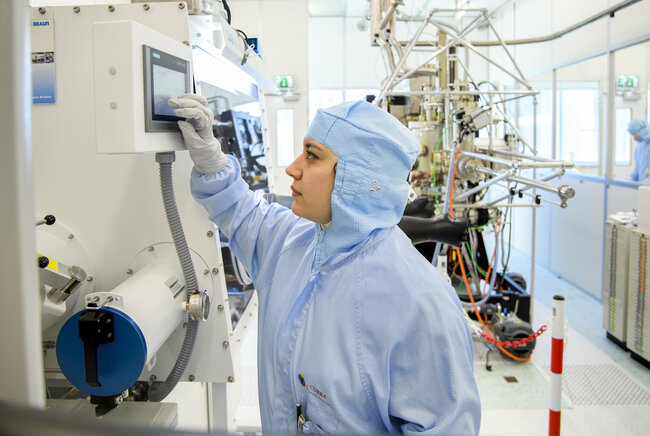Elham Fadaly wins Martinus van Marum Prize for breakthrough in photonics
TU/e alumna will receive KHMW's prestigious encouragement award, to recognize original research in the field of natural sciences and engineering, on Friday, July 7.

With her breakthrough to make silicon emit light, Elham Fadaly laid the foundation for the ‘holy grail’ in photonics: light-based computer chips. She received her PhD cum laude in 2021, published her breakthrough in Nature, and two different institutions named the discovery Breakthrough of the Year. On Friday, July 7, the TU/e alumna - currently working at Apple - will receive the prestigious Martinus van Marum Prize from the Royal Holland Society of Sciences (KHMW) for promising doctoral research. "If I know that something - at least in theory - is possible, then I will continue until it succeeds.”
Our world is pervaded with electronics – technology that processes information based on, as the name suggests, electricity. Signals in a processor of your phone or laptop, or in a data center consist of streams of electrons. For decades, scientists have, on the other hand, also been looking at light to send and process data.
The promise is that this so-called photonics is much faster and more economical than existing electronics and can meet the rapidly growing need for computing power due to increasing digitization and artificial intelligence, for example.
Many homes now have high-speed fiber-optic connections, and data centers also make extensive use of light connections. Yet the heart of our information technology is still electronic. Almost all the computational work is done in the semiconducting material silicon.
Alloy of silicon and germanium
Successful photonics must therefore be able to work seamlessly with existing electronics. But that is where things go wrong. This is because silicon is not capable of emitting light. During her PhD, Fadaly therefore looked for ways to modify silicon in such a way that it does. This would bring a laser from silicon within reach, a crucial element for making electronics and photonics much more compatible than they are now.
Eventually, Fadaly and colleagues managed to make an alloy of silicon and germanium emit light. The crux for this was getting the material to crystallize on a nanowire with a hexagonal structure. In this process, the atoms in the silicon and germanium adopt the hexagonal structure of the wire, instead of the material's usual quadrangular structure.
"The metal atoms continue to grow like the surface on which this happens, like a paver finishing a certain pattern with bricks," she says. "We had long been looking for ways to achieve this with a nanowire. We finally succeeded by doing this with a particular material - gallium arsenide."
![[Translate to English:] Elham Fadaly. Archieffoto: Vincent van den Hoogen](https://assets.w3.tue.nl/w/fileadmin/_processed_/3/3/csm_Fadaly_Elham_TN_VH_0880_PhD_f68156df82.jpg)
Eye for details
Fadaly received her PhD cum laude from TU/e in 2021, she published her research in Nature and her work was also awarded Breakthrough of the Year by two different bodies. And to this we now add the Martinus van Marum Prize. What makes her so successful? "I think I have an eye for details, and I am tenacious. During my PhD, I did maybe 800 or 900 experiments to grow the material the way we wanted. If I know something is possible - at least in theory - then I keep going until I succeed."
Fadaly's former supervisor, TU/e professor of Advanced Nanomaterials & Devices Erik Bakkers, confirms her enormous drive to work. "Elham is a very good researcher, and in the process, she works extremely hard and she only stops when she has succeeded. Those are very important qualities."
Photonics closer to consumers
Meanwhile, Fadaly has moved to California where she works for Apple in the field of photonics, which can also serve in biosensors. Here, she brings photonics one step closer to consumers. "In industry, you are more concerned with the final product, with the physics of components and actual devices. The application is much closer and that adds an extra layer to the work. I can still learn a lot here. We are pushing the boundaries of what is technologically possible here," she says.
When asked, her former supervisor Bakkers still hopes for another move from Fadaly: "I hope she will want to return to academia after her experience in industry."
About the prize and livestream
The Martinus van Marum Prize was established by the J.C. Ruigrok Foundation and is awarded to honor original doctoral research in the field of natural sciences and engineering. The prize is named after Martinus van Marum, who, as second secretary from 1794 to 1837, made a mark on the work of the Royal Holland Society of Sciences.
The award will be presented Friday, July 7, at 4 p.m. by Louise Gunning-Schepers, president of the KHMW. The award ceremony can be followed via the livestream button on the KHMW website. The program for the meeting is also available there.
More quantum and photonics research

![[Translate to English:] [Translate to English:]](https://assets.w3.tue.nl/w/fileadmin/_processed_/7/f/csm_BvOF%2001%20kickoff%20Future%20Chips%20Academy%20-%20group%20photo_5396222a83.jpg)
![[Translate to English:] [Translate to English:]](https://assets.w3.tue.nl/w/fileadmin/_processed_/a/9/csm_NGF%20Quantum%20Banner%20image_25d59cc135.jpg)
Latest news


![[Translate to English:] [Translate to English:]](https://assets.w3.tue.nl/w/fileadmin/_processed_/e/0/csm_BvOF%202019_1031_BHF%20license%20TUe%20ILI%20copy_8a50884392.jpg)